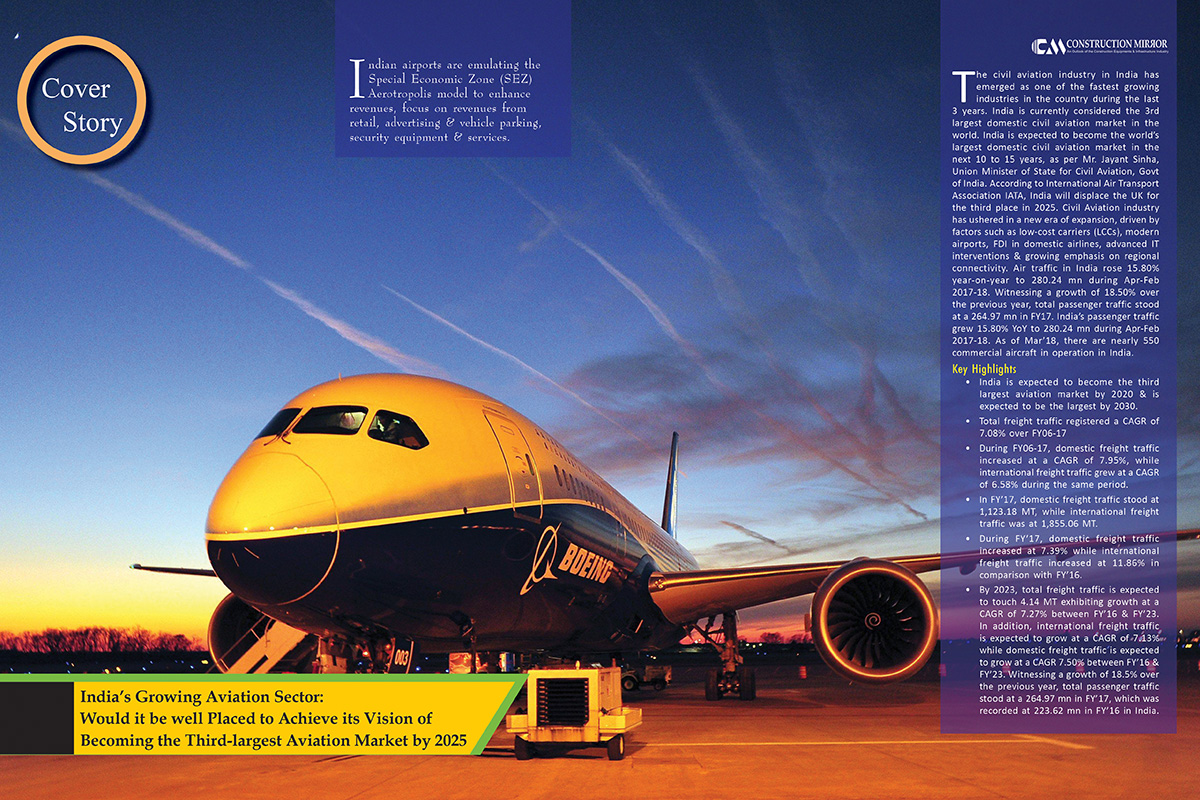India’s Growing Aviation Sector: Would it be well Placed to Achieve its Vision of Becoming the Third-largest Aviation Market by 2025
Indian airports are emulating the Special Economic Zone (SEZ) Aerotropolis model to enhance revenues, focus on revenues from retail, advertising & vehicle parking, security equipment & services.
The civil aviation industry in India has emerged as one of the fastest growing industries in the country during the last 3 years. India is currently considered the 3rd largest domestic civil aviation market in the world. India is expected to become the world’s largest domestic civil aviation market in the next 10 to 15 years, as per Mr. Jayant Sinha, Union Minister of State for Civil Aviation, Govt of India. According to International Air Transport Association IATA, India will displace the UK for the third place in 2025. Civil Aviation industry has ushered in a new era of expansion, driven by factors such as low-cost carriers (LCCs), modern airports, FDI in domestic airlines, advanced IT interventions & growing emphasis on regional connectivity. Air traffic in India rose 15.80% year-on-year to 280.24 mn during Apr-Feb 2017-18. Witnessing a growth of 18.50% over the previous year, total passenger traffic stood at a 264.97 mn in FY17. India’s passenger traffic grew 15.80% YoY to 280.24 mn during Apr-Feb 2017-18. As of Mar’18, there are nearly 550 commercial aircraft in operation in India.
Key Highlights
India is expected to become the third largest aviation market by 2020 & is expected to be the largest by 2030.
India is expected to become the third largest aviation market by 2020 & is expected to be the largest by 2030.
During FY06-17, domestic freight traffic increased at a CAGR of 7.95%, while international freight traffic grew at a CAGR of 6.58% during the same period.
In FY’17, domestic freight traffic stood at 1,123.18 MT, while international freight traffic was at 1,855.06 MT.
During FY’17, domestic freight traffic increased at 7.39% while international freight traffic increased at 11.86% in comparison with FY’16.
By 2023, total freight traffic is expected to touch 4.14 MT exhibiting growth at a CAGR of 7.27% between FY’16 & FY’23. In addition, international freight traffic is expected to grow at a CAGR of 7.13% while domestic freight traffic is expected to grow at a CAGR 7.50% between FY’16 & FY’23. Witnessing a growth of 18.5% over the previous year, total passenger traffic stood at a 264.97 mn in FY’17, which was recorded at 223.62 mn in FY’16 in India. Growth in passenger traffic has been strong since the new millennium, especially with rising incomes & low-cost aviation; during FY’06-17, passenger traffic grew at a CAGR of 12.39% in the country.
mn flyers, which will be more than that of Japan (just under 225 mn) & Germany (just over 200 mn) combined.
ndia has become the third largest domestic aviation market in the world & is expected to overtake UK to become the third largest air passenger market by 2025.
Growth in air passenger traffic at airports to decline further in fiscal 2019
CRISIL Research expects the air passenger traffic growth at Indian airports to decline to 14-16% in fiscal 2019, compared with 15-17% growth in fiscal 2018, mainly due to infra. constraints & rise in air fares. Overall passenger traffic at airports is projected to clock 12-14% CAGR between fiscals 2017 & 2022 -- with domestic traffic expected to grow by 13-15%, & international traffic by 9-10%. While the domestic share of total passenger traffic is pegged to increase, it is dependent on growth in GDP & airport infra. (through Greenfield & Brownfield projects), as well as a revival in the global economy. Till Oct’17, of the allocated routes for 45 UDAN airports, only 28 routes connecting 14 airports were operational. Among the five airlines that won routes in Phase I of Regional Connectivity Scheme, only 3 - Alliance Air, SpiceJet, & TruJet, have started operations. Moreover, these three airlines have commenced operations on only a few of their allocated routes, due to constraints at metro airports, & delays in acquiring requisite aircraft licenses. CRISIL Research expects the freight traffic at airports to grow by 11-13% in fiscal 2018, owing to an expected revival in the global economy, domestic growth, increasing connectivity on account of air service agreements, & a booming e-commerce industry. During the first half of fiscal 2018, international freight traffic increased 19%, due to movement of aircraft components, uncertainties due to implementation of GST, & movement of transit cargo, among other factors. During the second half of the fiscal, international freight traffic growth is expected to decline to 14-16%. Airport sector in India is set to see an investment of about Rs 1 lakh Cr. over a period of 5 years. The investments would be made in upgrading existing infra. at airports & also building greenfield airports by the Airports AAI & pvt. airport CoS. To ensure an infra. to facilitate a bn trips, there is going to be an investment of Rs 5 to 6 lakh Cr. In the next five years, we will see an investment of about Rs 1 lakh Cr. over a period of five years. Union cabinet approved upgrade of existing airports in the cities of Chennai, Lucknow & Guwahati. These projects will be implemented by the AAI at a cost of over Rs 5,082 Cr. Of the total amount, about 60% will be raised from the debt market & the rest will be from our funds. We will be following the same principle for the next five years too & raise about 60% of the Rs 21,000 Cr. to be invested by us in the next 5 years.
Can technology help keep the country’s air passengers moving
India’s air industry is booming. Passenger traffic is up way up & the country’s 22 operating commercial airlines are adding new routes & new aircraft at an amazing rate. In fact, based on its current trajectory, most observers expect the country to become the world’s third-largest aviation market by 2020. In some cities, the growth in air traffic has been astounding. In Bangalore, passenger air traffic has grown by almost 25 percent in each of the last 2 years. As Mr. Hari Marar, President & Executive Director at Bangalore International Airport Ltd notes, the tremendous growth in air traffic reflects both growing optimism in India’s economy & the changing nature of India’s economy. “Particularly in Bangalore, our economy is fueled by the services sector, which is people-intensive & requires a lot of travel. At the same time, almost half of the workers in Bangalore’s services sector come from outside of the city, so there is a lot of demand for air travel, not only for work, but also to see family & for leisure,” he notes. Breaking the choke hold However, India continues to struggle with sig. capacity challenges. By some accounts, just 75 of India’s airports are fully operational. & in the largest urban areas, airports are bursting at the seams. Indeed, up until 2008, Bangalore was served by a single-runway airport with capacity for just 3.6 mn passengers per year. Bangalore’s new airport, Kempegowda International Airport, opened in 2008. It now handles more than 22 mn passengers per year, with plans to expand capacity to 50 mn passengers by 2021. In part, the additional capacity will be achieved through the development of new assets. A second runway is nearing completion & a second terminal is now being constructed. Yet, as Mr. Marar notes, new facilities will only be part of the solution. “In the past, expanding capacity meant pouring more concrete. But, today, we are focused on finding ways to better utilize our existing capacity. Our belief is that, going forward, India’s main challenge will be to build smaller & smaller airports that can handle larger & larger volume of passengers.” The technology to soar Technology will be key to achieving those goals. “The game changer will be technology,” asserts Mr. Marar. “In today’s airports, passengers spend an inordinate amount of time in queues waiting to be processed. But if we apply better technology, we can start to process passengers as they walk through the airport, & that would allow us to utilize our existing capacity much more effectively.” Mr. Marar also expects technology to help improve operational efficiency by improving coordination between the various entities at the airport. “By creating a seamless exchange of information between all parties, we can deliver better customer experiences, achieve better operational efficiencies & improve key metrics, such as on-time performance & baggage handling.” Technology will also allow the airport to better serve customers & improve the overall customer experience. Mr. Marar notes that, in part, this will be achieved by improving passenger access to airport information which will enhance transparency & overall satisfaction. However, it will also allow the airport to better understand its customers & to create experiences that are better tailored to specific customer needs. Mr. Marar expects technology to help deliver on a range of other key objectives as well. “New technologies will allow us to improve our overall sustainability by helping us track & reduce our use of resources,” he says. “It will also allow us to improve employee engagement & satisfaction which, in turn, influences operational efficiency & customer satisfaction.” Creating the right environment While Mr. Marar has high expectations for technology, he also recognizes that technology is only part of the solution. Other structural & market reforms will also be needed if India is to meet the massive growth in demand for air travel. “From a structural capacity perspective, I worry that our airports will get choked in the big metro cities within the next decade & we’ll need new urban centers & airports in these new urban centers to take on that load,” he notes. “The airlines, too, will need to rethink their business model to move towards a far more distributed system than they have in the past.” At a national level, Mr. Marar suggests better integration between various modes of transport will be critical to delivering a better transportation solution to India’s citizens. “For travelers, the problem is how to get from point A to point B as quickly, safely & conveniently as possible. The problem is that, in India, we look at the various modes of transport in silos. We need to improve the integration between aviation, rail, road & shipping to deliver the transportation solutions that customer actually want.” Looking ahead, Mr. Marar is hugely optimistic about India’s air & transport industry. “Every market has risks but, in our case, I believe these risks are very manageable. Our regulatory regime has matured sig.ly over the past few years & investors are now almost guaranteed a healthy rate of return,” he argues. “At the same time, our govt has proven itself to be extremely proactive & reform-oriented, which enables growth & encourages risk-taking.” All signs suggest that India’s air travel market will continue to grow & prosper. “It’s a very exciting market right now & there are massive opportunities for foreign investors, developers & technology CoS,” he suggests. “India’s airports sector is a great place to invest for the long term.
Sector Overview
India is the world’s fastest growing domestic aviation market, & has posted the fastest full year growth rate for three years in a row now. India’s Revenue Passenger Kilometre (RPK) growth of 17.5% was higher than the global average growth of 7% in 2017. At USD 16 bn, India’s aviation market is currently the 9th largest in the world & is projected to be the 3rd largest by 2020, & largest by 2030. More than 80 international airlines connecting to over 40 countries. India is projected to be the third largest aviation market by 2020, & the largest by 2030. The Indian aviation sector is likely to see investments totalling USD 15 bn during 2016-2020 of which USD 10 bn is expected to come from the pvt. sector. Airport Authority of India (AAI) plans to revive & operationalize around 50 airports in India over the next 2 years to improve regional & remote air connectivity. Growth in aviation is also increasing demand for MRO (maintenance, repair & overhaul) facilities. Greater focus on infra. development – increasing liberalization - Open Sky Policy; AAI driving modernization of airports & Air & Navigation Systems. Five international airports (Delhi, Mumbai, Cochin, Hyderabad, Bengaluru) are operational under Public Pvt. Partnership (PPP) mode. Enhanced Skill Development – Clear focus to leverage India’s human capital potential & create job opportunities. Innovation & Technology – Launched GPS Aided Geo Augmented Navigation (GAGAN): India’s first satellite based navigation system; NO Objection Certificate Application System (NOCAS): streamlines online process of timely NOC for height clearances of buildings around airports; E-Governance for Civil Aviation (eGCA): online delivery of 162 licensing & regulatory processes of DGCA. Domestic passenger traffic crossed the 100 mn mark in 2017, reaching 106 mn in the January to November period. India is the fastest growing aviation market & is expected to cater to 478 mn passengers by 2036. India is one of the least penetrated air markets in the world with 0.04 trips per capita per annum as compared to 0.3 in China & more than 2 in the USA (2016). FDI policy: Airports - 100% allowed under Automatic route for both greenfield as well as brownfield projects. Air transport services -Scheduled Air Transport Service/Domestic Scheduled Passenger Airline/Regional Air Transport Service. Up to 49% allowed under Automatic route. Govt approval required beyond 49%. Non-Scheduled Air Transport Services & Helicopter services/seaplane services requiring DGCA approval. 100% allowed under Automatic route. Other services under the Civil Aviation sector. Ground Handling Services & Maintenance Repair & Overhaul Services. 100% allowed under Automatic route.
India is the world’s fastest growing domestic aviation market, & has posted the fastest full year growth rate for three years in a row now. India’s Revenue Passenger Kilometre (RPK) growth of 17.5% was higher than the global average growth of 7% in 2017. At USD 16 bn, India’s aviation market is currently the 9th largest in the world & is projected to be the 3rd largest by 2020, & largest by 2030. More than 80 international airlines connecting to over 40 countries. India is projected to be the third largest aviation market by 2020, & the largest by 2030. The Indian aviation sector is likely to see investments totalling USD 15 bn during 2016-2020 of which USD 10 bn is expected to come from the pvt. sector. Airport Authority of India (AAI) plans to revive & operationalize around 50 airports in India over the next 2 years to improve regional & remote air connectivity. Growth in aviation is also increasing demand for MRO (maintenance, repair & overhaul) facilities. Greater focus on infra. development – increasing liberalization - Open Sky Policy; AAI driving modernization of airports & Air & Navigation Systems. Five international airports (Delhi, Mumbai, Cochin, Hyderabad, Bengaluru) are operational under Public Pvt. Partnership (PPP) mode. Enhanced Skill Development – Clear focus to leverage India’s human capital potential & create job opportunities. Innovation & Technology – Launched GPS Aided Geo Augmented Navigation (GAGAN): India’s first satellite based navigation system; NO Objection Certificate Application System (NOCAS): streamlines online process of timely NOC for height clearances of buildings around airports; E-Governance for Civil Aviation (eGCA): online delivery of 162 licensing & regulatory processes of DGCA. Domestic passenger traffic crossed the 100 mn mark in 2017, reaching 106 mn in the January to November period. India is the fastest growing aviation market & is expected to cater to 478 mn passengers by 2036. India is one of the least penetrated air markets in the world with 0.04 trips per capita per annum as compared to 0.3 in China & more than 2 in the USA (2016). FDI policy: Airports - 100% allowed under Automatic route for both greenfield as well as brownfield projects. Air transport services -Scheduled Air Transport Service/Domestic Scheduled Passenger Airline/Regional Air Transport Service. Up to 49% allowed under Automatic route. Govt approval required beyond 49%. Non-Scheduled Air Transport Services & Helicopter services/seaplane services requiring DGCA approval. 100% allowed under Automatic route. Other services under the Civil Aviation sector. Ground Handling Services & Maintenance Repair & Overhaul Services. 100% allowed under Automatic route.
Investment opportunities: MRO, ground handling, cargo & ATF infra. facilities collocated at an airport, (including heliport licensed by DGCA) are covered under the ‘Harmonised List of Infra. & will get the benefit of ‘infra.’ sector. 300 business jets, 300 small aircraft & 250 helicopters are expected to be added to the current fleet of Indian carriers in the next five years. Demand for MRO facilities is increasing in India, due to growth in the aviation sector. Investment opportunities worth USD 3 bn in greenfield airports under PPP at Navi Mumbai & Mopa (Goa). The development of new airports – the Airport Authority of India (AAI) aims to bring around 250 airports under operation across the country by 2020. For development of aviation in the North-east region – the AAI plans to develop Guwahati as an inter-regional hub & Agartala, Imphal & Dibrugarh as intra-regional hubs. AAI has planned to spend USD 3 bn on non-metro projects between 2016 & 2020, focusing on the modernisation & up-gradation of airports. Indian airports are emulating the Special Economic Zone (SEZ) Aerotropolis model to enhance revenues, focus on revenues from retail, advertising & vehicle parking, security equipment & services.
According to data released by the DIPP, FDI inflows in air transport (including air freight) between Apr’00 & Dec’17 stood at US$ 1,608.51 mn. India is est. to see an investment of US $25 bn in the next decade in the airports sector, & traffic growth of 13%, according to Morgan Stanley. According to them, the share of air travel in air & rail travel combined in India will grow to 15.2% by 2027 from 7.9% now. Capex plans to the tune of Rs 65,000 Cr. have been finalised by the Airports Authority of India with Rs 17,500 Cr. for the next 5 years & around Rs 22,000 Cr. for brownfield expansion in Delhi, Mumbai, and Hyderabad & Bengaluru by pvt. operators & around Rs 21,000 Cr. for greenfield airports. Key investments & developments in India’s aviation industry include: AAI is going to invest Rs 15,000 Cr. in 2018-19 for expanding existing terminals & constructing 15 new ones. AAI will undertake new development works at Lucknow, Deoghar, Rajkot & Allahabad airports. The objective is to improve & develop airport infra. to meet growing traffic demands. AAI plans to construct new integrated passenger terminal building at Chaudhary Charan Singh International Airport, Lucknow at an est. cost of Rs. 1,230 Cr. The new terminal will be able to handle 4000 passengers during peak hour & 6.35 mn passengers per annum. Few Foreign investors in India are - Airbus (France); Boeing International Corporation (USA); AirAsia (Malaysia); Rolls Royce (UK); Frankfurt Airport Services Worldwide (Germany); Honeywell Aerospace (USA); Malaysia Airports Holdings Berhad (Malaysia); GE Aviation (USA); Airports Co. South Africa Global (South Africa); Alcoa Fastening Systems Aerospace (USA); Singapore Airlines (Singapore); Etihad Airways (UAE); Fairfax (London).
India plans to build 100 more airports for 1bn flyers by 2035
world, the country plans to increase the no. of airports to between 150 & 200 by 2035, from around 100 at present. The expansion could cost more than $60 bn, with the pvt. sector expected to foot most of the bill. To lure investment, the govt hopes to implement policies to ensure that pvt. investors can recover their money & earn solid returns. Ultimately, India should have 150 to 200 airports in the next 15-20 years. In the next 12 months, we will have over 131 active airports, a no. that includes airports already under construction. A soon-to-open facility in the state of Sikkim offers an e.g. of how connectivity stands to improve. The state, which shares borders with China, Nepal & Bhutan, has never had an airport. Travelers to the capital of Gangtok had to endure a bumpy, four-hour-plus ride from the nearest airport in Bagdogra, in neighboring West Bengal. Now, the newly constructed Pakyong airport, near Gangtok, is scheduled to open in June. This will connect the airport in Kolkata, West Bengal’s capital, with 70-minute flights. According to the Ministry of Civil Aviation, the no. of domestic & international passengers totaled more than 139 mn in 2017, a 17% increase over 2016. The no. of domestic passengers, who account for more than 80% of the total, has seen double-digit growth for the 42nd consecutive month, dating back to Sep’14.
“India posted the fastest domestic passenger growth in 2017 for the third year in a row, followed by China & Russia,” said the International Air Transport Association. The surge in passengers is largely attributable to heated competition among airlines, which has brought down fares. In mid-2014, only seven airlines were flying domestically. By mid-2016, the no. was up to 12. Ministry of Civil Aviation said average airfare fell 18% in 2016, from year before. It still costs considerably more to fly than to travel by train. The cheapest one-way air ticket from Delhi to Ahmedabad costs about 3,000 rupee, while a basic train fare is just 475 rupees. But GoI is looking to narrow the gap under a policy launched last year. Idea is to offer govt subsidies & cap fares at Rs. 2,500 for hour-long flights connecting with rural towns. The current pace of passenger growth in India is likely to continue. Over the next 15-20 years, the U.S., China & India will each handle more than 1 bn passengers. 90% of Indians should be within 100km of an airport. The target of 150-200 airports is thought to include small airports, formerly excluded from past counts. Total investment may reach 4 trillion rupees. This is 60 times more than the ministry’s fiscal 2018 budget. A consultant is being appointed to est. the projected demand across the country & in individual cities, determines req. investments, identify possible sources of funding, & develop a regulatory architecture in consultation with shareholders. Most of it will be financed by the pvt. sector. India needs 150 to 200 airports. But questions remain as to whether pvt. CoS will heed the govt’s call for investment. The outlook for India’s aviation sector is very positive & growth will be incredibly strong. For the airport projects, the pvt. sector will invest as long as there is some clarity on economic regulations, such as rate of return & what kind of regulatory framework is in place, specifically whether regulations will apply only to aeronautical charges, or also retail duty-free charges. India currently has 5 airports that are operated under public-pvt. partnerships. Airports in Delhi & Mumbai were built & initially managed by the govt, which later put management under pvt. control. The pvt. sector, meanwhile, constructed & managed airports in Bangalore, Hyderabad & Cochin from the outset. India has already removed restrictions on foreign capital as regards airport management. AAI & the local govt’s Telangana each have a 13% stake in Hyderabad’s airport, while GMR Group, an Indian port operator, claims 63% & Malaysia Airports Holdings 11%.
“India posted the fastest domestic passenger growth in 2017 for the third year in a row, followed by China & Russia,” said the International Air Transport Association. The surge in passengers is largely attributable to heated competition among airlines, which has brought down fares. In mid-2014, only seven airlines were flying domestically. By mid-2016, the no. was up to 12. Ministry of Civil Aviation said average airfare fell 18% in 2016, from year before. It still costs considerably more to fly than to travel by train. The cheapest one-way air ticket from Delhi to Ahmedabad costs about 3,000 rupee, while a basic train fare is just 475 rupees. But GoI is looking to narrow the gap under a policy launched last year. Idea is to offer govt subsidies & cap fares at Rs. 2,500 for hour-long flights connecting with rural towns. The current pace of passenger growth in India is likely to continue. Over the next 15-20 years, the U.S., China & India will each handle more than 1 bn passengers. 90% of Indians should be within 100km of an airport. The target of 150-200 airports is thought to include small airports, formerly excluded from past counts. Total investment may reach 4 trillion rupees. This is 60 times more than the ministry’s fiscal 2018 budget. A consultant is being appointed to est. the projected demand across the country & in individual cities, determines req. investments, identify possible sources of funding, & develop a regulatory architecture in consultation with shareholders. Most of it will be financed by the pvt. sector. India needs 150 to 200 airports. But questions remain as to whether pvt. CoS will heed the govt’s call for investment. The outlook for India’s aviation sector is very positive & growth will be incredibly strong. For the airport projects, the pvt. sector will invest as long as there is some clarity on economic regulations, such as rate of return & what kind of regulatory framework is in place, specifically whether regulations will apply only to aeronautical charges, or also retail duty-free charges. India currently has 5 airports that are operated under public-pvt. partnerships. Airports in Delhi & Mumbai were built & initially managed by the govt, which later put management under pvt. control. The pvt. sector, meanwhile, constructed & managed airports in Bangalore, Hyderabad & Cochin from the outset. India has already removed restrictions on foreign capital as regards airport management. AAI & the local govt’s Telangana each have a 13% stake in Hyderabad’s airport, while GMR Group, an Indian port operator, claims 63% & Malaysia Airports Holdings 11%.
Aviation traffic rises at fastest pace
Passenger air traffic in India grew at the fastest pace in 13 months in February, even as fears mount over demand weakening due to rising air fares. The no. of passengers flown last month jumped almost 24% on-year to 10.7 mn, according to govt data. Air travel in India traditionally records a spurt from Oct through Mar, rebounding from a lean period in the previous months. The country’s air travel has grown at an annual pace of more than 20% in the past few years as rising incomes & the advent of no-frills carriers prompted more people to shun trains for long-distance travel. A sharp fall in fuel prices also allowed airlines to lower fares. The south Asian nation is already the third-largest aviation market behind the U.S. & China with domestic traffic of more than 100 mn passengers. However, govt move earlier this month to ground 11 A320neo aircraft owned by market leader InterGlobe Aviation’s IndiGo & smaller rival GoAir due to engine issues have roiled the market’s stability. The regulator’s decision to ground the aircraft & the cancellation of flights had resulted in a fairly sig. impact on the airfares on some key routes. Initially, there was a spike in fares for routes which had the max. no. of cancellations including Delhi & Mumbai. With current load factors at over 90%, this reduction in capacity is likely to result in a 5%-10% increase in fares on key routes in the short to medium term. India’s aviation regulator ordered the immediate grounding of Airbus A320neo aircraft fitted with certain Pratt & Whitney engines after a series of engine failures. Govt order came after IndiGo grounded 3 aircraft due to the same issues. Since then, IndiGo & GoAir have cancelled hundreds of flights. While IndiGo would be cancelling more than 900 flights, GoAir has decided to take down 138 flights, Bloomberg Pratt & Whitney’s Indian episode is similar to its troubles in other parts of the world, including in the U.S., where the aviation regulator said in Feb that the engines pose a shutdown risk. , Pratt & Whitney said it will resolve matter by the. Meanwhile, the industry is already grappling with rising fuel costs. Aviation turbine fuel prices, which account for more than a third of the industry’s costs, are expected to rise more than 12% this quarter. Analysts were expecting the fares to increase gradually to absorb the fuel costs, based on the assumption that airlines will add more capacity. Between Jan & Feb, domestic airlines have carried about 22.2 mn passengers, up more than 22% from a year earlier, the govt data showed. IndiGo filled nearly 92% of its seats in February, compared with 90% in January, while state- owned Air India saw its so-called load factor rise to 87% from the previous month’s 85%. Jet Airways (India) filled 90% of its seats, compared with 89% in January. Third-ranked SpiceJet filled more than 96% of its seats, while the load factor at India’s newest carrier Vistara rose to 91%. Budget airline AirAsia saw its load factor expand to 88%. The fleet reduction by IndiGo & GoAir is likely to boost the load factors at rivals Air India & Jet Airways, as well as some of the smaller operators who are running on lower capacity utilization, say analysts. “More than capacity-growth issues, the Co. (Indigo) will need to grapple with perception issues,” Citigroup said in a report. “We do not rule out some customers veering towards other operators, at least over the near term.” Shares of InterGlobe gained 2.4%, while that of SpiceJet closed 0.9% higher in Mumbai trading. Jet Airways lost 0.5%, while the benchmark S&P BSE Sensex gained 0.2%.
Govt Initiatives and Road Ahead
Some major initiatives undertaken by the govt are: Allocation to Civil Aviation Ministry has been tripled to Rs 6,602.86 Cr. under Union Budget 2018-19. In February 2018, the Prime Minister of India launched the construction of Navi Mumbai airport which is expected to be built at a cost of US$ 2.58 bn. The first phase of the airport will be completed by end of 2019. Under the second round of Regional Connectivity Scheme (RCS 2) the govt has awarded 325 routes to airlines as well as helicopter operators with the objective of enhancing flight services to hilly & remote areas. Under the scheme airline operators have to offer half of their seats at discounted rates & helicopter operators can offer up to 13 seats at lower fares with the govt providing VGF or subsidy to airlines & helicopter operators. Constructing 17 highways-cum-airstrips are the govt’s priorities & it will start work on them this year, Union Minister Nitin Gadkari has said. The projects are designed in such a fashion that the roads will double up as airstrips & traffic will be stopped when an airplane lands or takes off. The road & air connectivity will also provide better access to remote areas. Airport building & modernization projects worth over Rs 19,300 Cr. have been recommended green clearance, in line with the Govt of India’s focus on improvement in regional air connectivity. India’s aviation industry is largely untapped with huge growth opportunities, considering that air transport is still expensive for majority of the country’s population, of which nearly 40% is the upwardly mobile middle class. The industry stakeholders should engage & collaborate with policy makers to implement efficient & rational decisions that would boost India’s civil aviation industry. With the right policies & relentless focus on quality, cost & passenger interest, India would be well placed to achieve its vision of becoming the third-largest aviation market by 2025. In the coming 20 years, Indian CoS will buy 2,100 new planes worth US$ 290 bn. Also, domestic air traffic in India is expected to cross 150 mn in FY19, on the back of unprecedented capacity induction by airlines.
















Leave a comment